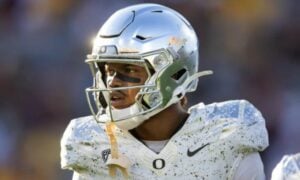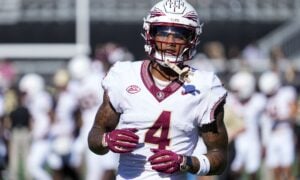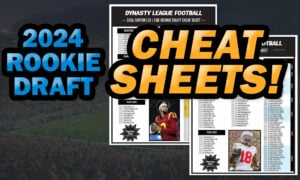2015 Market Share Report: Running Backs
Now, more than ever, dynasty owners are looking to grab their starting running backs at a discount due to the volatility at the position. Can you blame them? Injuries, committees, and roster turnover have made the position dispensable and paying a premium for a running back has turned into a massive risk. The cheapest way to acquire the next breakout running back is through the draft. Both David Johnson and Thomas Rawls were cheap acquisitions during last year’s rookie drafts. Obviously, not every draft has mid-late round running backs who break out during their rookie season, but through proper research you can increase the odds of finding the next break out running back.
Marketshare production is one of the key metrics to analyze while evaluating prospects, because it gives a different display of the prospect’s production. It takes account of the player’s value within the offense and it curtails the inflation from teams with high volume offenses. It shouldn’t be the only metric or method in your process, but it will provide a quick overview on a player’s college production.
I split the data up by class, which makes it beneficial for rookie and devy drafts because it gives you an educated guess on the player’s break out age. Since running backs are used in the passing game we will weigh their rushing and receiving yardage against their team’s total yards. Running backs who are used heavily in the passing game can experience an increased marketshare of the offense due to having a large role in both the rushing and receiving spectrums of the offense. .
One thing you will notice (and it may not be a surprise to most): the sophomore class is stacked compared to the other classes with running backs who own a large share of their offense. The sophomore class has nine running backs with over 30 percent market share, compared to the junior and senior classes combined, who only have eight running backs total with over 30 percent market share of the offense. This is one of the reasons why dynasty owners have been salivating over the stock of talent that is projected for the 2017 NFL Draft.
[am4show have=’g1;’ guest_error=’sub_message’ user_error=’sub_message’ ]
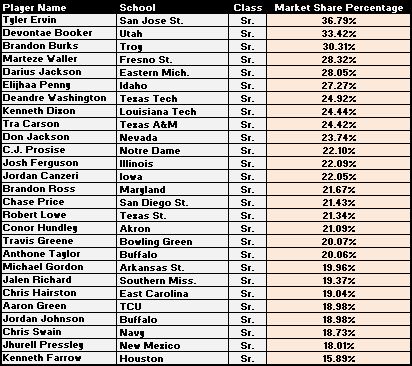
Devontae Booker, RB Utah
Booker is one of the top rated running backs in this year’s draft, and he’s ranked sixth in DLF’s rookie rankings. It’s not a surprise he took over a large market share of Utah’s offense, since he was the focal point of their weekly game plan. His receiving production of 37 receptions for 316 yards helped elevate his share of the offense.
Kenneth Dixon, RB Louisiana Tech
He only played in ten of Louisiana Tech’s 13 games last season due to an ankle injury which curtailed his market share of the offense. He had five games with over 100 yards rushing and three games with over 50 yards receiving.
C.J. Prosise, RB Notre Dame
Prosise, a former wide receiver, inherited the starting running back duties after Tarean Folston tore his ACL during the season opener. Once he got the job he didn’t look back by rushing for 1,029 yards and eleven touchdowns.
Josh Ferguson, RB Illinois
He only played in nine games last season and was still able to capture a large portion of the team’s offensive production. He’s a very intriguing prospect because he’s very good at catching the ball out of the backfield. He caught 168 receptions for 1,507 yards and eight touchdowns during his collegiate career.
Jordan Canzeri, RB Iowa
He missed two complete games due to a knee injury and was limited in a couple more games with other injuries. Even with a decent portion of the season lost due to injuries, he was still able to seize a large portion of the team’s yearly output. He was very productive with five games with over 100-yards rushing and he dominated Illinois during week six with 271 total yards.
Aaron Green, RB TCU
Green caught a lot of people’s eyes during the Senior Bowl as he made a nice run where he demonstrated excellent vision and patience for a 25-yard touchdown. He had five games last season where he rushed for over 100-yards. His lack of use in the passing game limited his market share within the offense as he caught just 16 receptions for 117 yards and one touchdown.
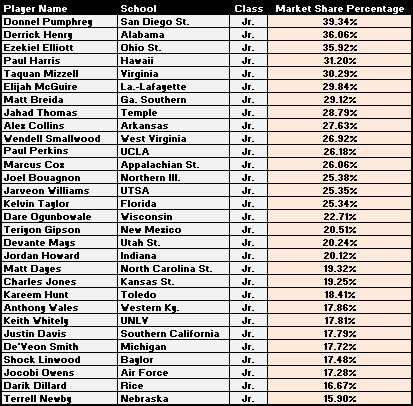
Donnel Pumphrey, RB San Diego St.
Pumphrey’s career has been very productive so far, as he finished fourth in the nation in rushing in 2014 and he finished seventh in 2015. He’s a player we will need to keep an eye on next year during his senior season.
Derrick Henry, RB Alabama
Henry is going to be one of the top running back prospects in this year’s draft. He led the nation in rushing with 2,219 yards and 28 rushing touchdowns. His market share percentage is another key performance indicator to why he should be selected in the first round of rookie drafts.
Ezekiel Elliott, RB Ohio State
Elliott will be a first round draft pick as he’s easily one of the top skilled players in this year’s draft. He has accumulated 3,961 yards and 43 touchdowns rushing during his collegiate career, and has only had six games during that least two seasons where he failed to eclipse the 100-yard mark.
Taquan Mizzell, RB Virginia
Mizzell’s receiving production elevated his market share within Virginia’s offense as he caught 75 receptions for 721 yards and four touchdowns last season. His influence in the passing game was very consistent as he averaged 6.25 receptions per game and 29.76 percent of the team’s catches.
Alex Collins, RB Arkansas
He was third in the SEC in rushing with 1,577 yards and 20 touchdowns. He was the team’s workhorse running back last season as he averaged 20 rushing attempts per game. He was very productive during his collegiate career and should be monitored closely during the draft process.
Paul Perkins, RB UCLA
He’s another intriguing prospect that will be on a lot of people’s radar during rookie draft season. He was third in the PAC-12 in rushing with 1,343 yards and he had five games with over 100-yards rushing.
Jordan Howard, RB Indiana
Howard was leading the Big Ten in rushing until he injured his ankle against Ohio State during week five. He encountered some more injuries that set him back during the end of the season, but he still managed to own 20.12 percent of the team’s offensive production. Howard’s biggest game came against Michigan where he rushed for 238 yards and two touchdowns. Landing spot in the NFL Draft is going to be huge for his dynasty value.
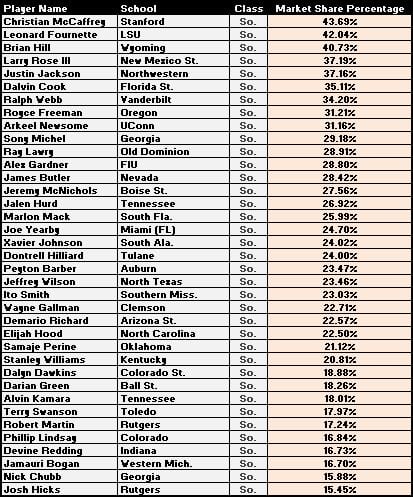
Christian McCaffrey, RB Stanford
McCaffrey was practically the entire offense for Stanford, as he led his team in both rushing and receiving. He accounted for 21.76 percent of the receiving yards and 21.13 percent of the receptions for his team. He is undervalued when you take into account his statistical output compared to the other players in college football.
Leonard Fournette, RB LSU
Right now, he is the darling of next year’s draft as he is the stud player dynasty owners are drooling over a year and a half before they can think about their rookie drafts. The excitement is due to the dominance that he displays on the field, as he had nine games where he rushed for at least 100-yards and three of those nine games he rushed for over 200 yards.
Justin Jackson, RB Northwestern
He’s another prospect to keep an eye on next season because he rushed for over 1,000 yards during both his freshman and sophomore seasons. Northwestern’s philosophy is to control the clock by running the football and playing strong defense, which makes Jackson an important piece to their team. The quarterbacks for Northwestern only passed 1,801 yards during the entire season, so Jackson’s rushing production didn’t get diluted from the passing game as much as most prospects.
Dalvin Cook, RB Florida State
Cook is considered one of the top running backs in college football. He led the ACC in rushing with 1,691 yards last year. He’s a very dynamic player and he should be one of the top running back prospects in next year’s draft.
Royce Freeman, RB Oregon
Oregon’s offense finished last season ranked eighth in the nation in total offense with 6,997 yards and Freeman managed to capture 31.21 percent of his team’s offensive output. His work in the passing game helps elevate his share in offense as he caught 26 receptions for 348 yards and two touchdowns. He’s going to be one of the top prospects in next year’s draft class, because of his athleticism, size and production.
Sony Michel, RB Georgia
Michel, a five star recruit from Plantation Florida, has been waiting in the wings behind Nick Chubb to get his chance at becoming the lead back for the team. Chubb’s season ended early due to a brutal knee injury during week six against the Tennessee volunteers. Michel took the reins and finished the season rushing for 1,161 yards and eight touchdowns.
Joseph Yearby, RB Miami
His involvement in the passing game helped elevate his market share percentage by catching 23 receptions for 273 yards and two touchdowns. He had three games where he eclipsed the century mark in rushing yards.
Wayne Gallman, RB Clemson
He was the workhorse back for the Clemson Tigers last season with 282 rushing attempts. He finished the season second in the ACC in rushing with 1,527 yards. His draft stock will increase scientifically if he has another productive season.
Elijah Hood, RB North Carolina
He had eight games with over 100 yards rushing as he finished the season rushing for 6.7 yards per carry. He’s another running back to keep an eye on next season as his stock could pick up steam with another solid season.
Samaje Perine, RB Oklahoma
Perine shared a lot of the workload with freshman running back Joe Mixon, which unfortunately cut into his market share of the offensive production. He broke out during his freshman season, rushing for 1,713 yards and 21 touchdowns. He’s another prospect who will be highly regarded in rookie drafts next year.
Nick Chubb, RB Georgia
Chubb tore his PCL and two other ligaments during week six against Tennessee which ended his season. Before the injury Chubb posted five straight games with over 100-yards rushing. He took over 15.88 percent of his team’s offensive production while playing in just five full games. Chubb would have been one of the top players in the nation when it came to market share percentage if it wasn’t for his season ending prematurely due to the knee injury.
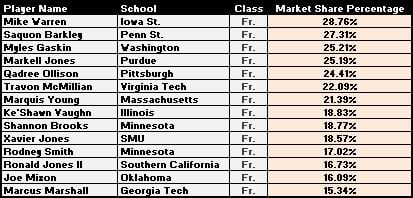
Saquon Barkley, RB Penn State
Barkley demonstrated last season that he could be one of the top running backs for the next few years. Even with missing two games and playing limited action during the season opener against Temple, he still managed to control a large market share of the offense. His most impressive game came against Ohio State where he rushed for 194 yards while averaging 7.5 yards per carry.
Myles Gaskin, RB Washington
Gaskin had eight games with over 100-yards rushing which helped him finish fourth in the PAC-12. Players are extra intriguing when they break out during their freshman season, and that’s what Gaskin did. He is a player to keep an eye on during the next few years.
Market share data is a good tool for evaluating prospects, especially when you use it in conjunction with watching tape and researching athletic and efficiency metrics. Leave no stone left unturned by studying every facet of a player’s profile. The harder you work, the luckier you get in rookie drafts.
[/am4show]
- 2024 NFL Draft: What We Expect for Day 3 - April 27, 2024
- 2024 NFL Draft: What We Expect for Day 2 - April 26, 2024
- 2024 NFL Draft: What We Expect for Day 1 - April 25, 2024






